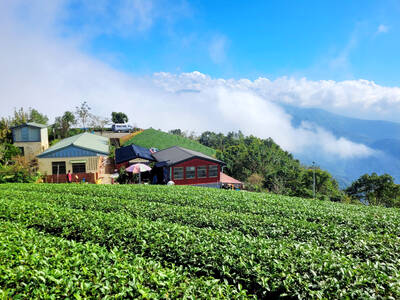The Marshall Islands should be of particular interest in Taiwan as they form a country with full diplomatic ties to Taipei. Close to both the equator and the International Date Line, the island group took its name from a Briton, Captain Marshall, who visited them in the 18th century when taking prisoners sentenced to transportation to Australia. But they’re best known as containing Bikini Atoll where the US conducted a long series of nuclear tests beginning in 1946, with the name subsequently becoming attached to the ultra-miniature swimsuit.
The young Californian Peter Rudiak-Gould was posted there as an expatriate teacher with WorldTeach and spent a year on the tiny island of Ujae. It took him 45 minutes to walk round its entire coastline, he relates, and five minutes to walk from the lagoon side to the ocean side. Education levels are apparently low on the Marshalls, and the record of Rudiak-Gould’s school was one of the worst. His pupils couldn’t point to either the Marshall Islands or the US on a world map on his first day of teaching.
The book’s title, Surviving Paradise, is of course ironic — paradise is somewhere you’re supposed to lose your heart to, not struggle to survive. It’s typical of the clipped irony that characterizes the author’s prose style generally. He was a mere 21 when he went there, and not much older when he penned this book. He went on to pursue graduate studies in anthropology at Oxford, but the humor remains notably unassuming and even self-effacing. Some of the book’s perceptions, however, are a good deal more tart.
The value of this book is consequently as a contribution to studies of the Marshall Islands, not a genre known for being particularly thick on the shelves. (There you are — I’m falling into Rudiak-Gould’s style of quiet irony already). It certainly doesn’t make for gripping reading in the manner of Paul Theroux, a writer in a totally different class who the publishers nonetheless see fit to evoke on the cover. Rudiak-Gould’s irony is too mild and good-mannered to bear comparison with Theroux’s characteristic outrageousness, not to mention his devastating and freely dispensed insightfulness.
The daily lives of the Ujae locals may have been unexceptional — two flights a month, little Protestant churches, lunches consisting solely of rice — but there were natural wonders on the uninhabited atolls nearby. There were frigate birds, “their bodies absurdly tiny between their huge pterodactyl wings,” and clams almost a meter across, with shells so hard the ancient Marshallese had made adze blades out of them.
Though they now constitute an independent nation, the Marshalls still receive generous subsidies from the US. The author visited an American military base on Kwajalein Atoll. In its lagoon, he writes, unarmed missiles from California, 8,000km away, had from time to time either landed or been shot down. They were test flights for National Missile Defense technology.
As for the former residents of Bikini, they’d received such lavish compensation that they now lived a lifestyle far removed from any others on the islands. They had electricity, running water, air-conditioning, cars and a gymnasium, and the men never learned to spearfish because tuna came from a can. “The bomb had injured their self-reliance,” Rudiak-Gould writes with characteristic urbanity, “but it was the new wealth that had killed it.”
The author’s own intrinsic Western-ness is instructively described. On a visit back to the capital, Majuro, to meet his fellow teachers, he understands for the first time how much he loves his own culture. “It wasn’t the West’s wealth or power. It was the fact that friends hugged each other; that men and women freely interacted; that children were openly treasured; that both intimacy and anonymity were possible; that a person could determine his own path in life.” Elsewhere, though, he’s not so generous about his home country.
There were many other foreigners in Majuro, including a transsexual Thai hairdresser, an “affable Taiwanese ambassador,” and an often distrusted community of Chinese immigrants. The reason for the distrust of these last residents was the same as that expressed against similar new arrivals the world over — that they made too much money too quickly. But the facts were probably that they worked harder than the locals, then saved and invested, and that the locals were quick to use their efficient and plentifully stocked shops, but then resented the owners’ resulting prosperity.
At one point in this book there’s what looks like controversial material relating to Taiwan’s Aborigines. On page 92 the author describes the ubiquitous Pacific outrigger and asserts that more than 5,000 years ago it “allowed the indigenous people of Taiwan — the Austronesians — to settle almost every inhabitable island across half the globe,” regularly sail 3,000km to Hawaii, found “the world’s most remote civilization” on Easter Island, discover Madagascar, and bring back the sweet potato from South America. I’ve encountered some dramatic claims for the original Taiwanese, but never one as far-reaching as this.
It was probably the publishers who suggested adding global warming to the book’s title — “One Year on a Disappearing Island.” The author himself doesn’t treat the topic until near the end of the book, and when he does so it’s in a characteristically undramatic way. Yes, ocean levels are set to rise, but nothing very worrying is happening yet.
This, then, is a pleasantly written account, full of information about a little-known place, and testimony to the virtues of sanity and keeping a cool head.
But what’s the truth about the Taiwan’s Aborigines? Some scholars have suggested the Austronesian diaspora may indeed have begun here, but it’s by no means the orthodox view. There’s neither bibliography nor footnotes in this book. It would be useful to know more about Rudiak-Gould’s sources.

In recent weeks the Trump Administration has been demanding that Taiwan transfer half of its chip manufacturing to the US. In an interview with NewsNation, US Secretary of Commerce Howard Lutnick said that the US would need 50 percent of domestic chip production to protect Taiwan. He stated, discussing Taiwan’s chip production: “My argument to them was, well, if you have 95 percent, how am I gonna get it to protect you? You’re going to put it on a plane? You’re going to put it on a boat?” The stench of the Trump Administration’s mafia-style notions of “protection” was strong

Every now and then, it’s nice to just point somewhere on a map and head out with no plan. In Taiwan, where convenience reigns, food options are plentiful and people are generally friendly and helpful, this type of trip is that much easier to pull off. One day last November, a spur-of-the-moment day hike in the hills of Chiayi County turned into a surprisingly memorable experience that impressed on me once again how fortunate we all are to call this island home. The scenery I walked through that day — a mix of forest and farms reaching up into the clouds

With one week left until election day, the drama is high in the race for the Chinese Nationalist Party (KMT) chair. The race is still potentially wide open between the three frontrunners. The most accurate poll is done by Apollo Survey & Research Co (艾普羅民調公司), which was conducted a week and a half ago with two-thirds of the respondents party members, who are the only ones eligible to vote. For details on the candidates, check the Oct. 4 edition of this column, “A look at the KMT chair candidates” on page 12. The popular frontrunner was 56-year-old Cheng Li-wun (鄭麗文)

Oct. 13 to Oct. 19 When ordered to resign from her teaching position in June 1928 due to her husband’s anti-colonial activities, Lin Shih-hao (林氏好) refused to back down. The next day, she still showed up at Tainan Second Preschool, where she was warned that she would be fired if she didn’t comply. Lin continued to ignore the orders and was eventually let go without severance — even losing her pay for that month. Rather than despairing, she found a non-government job and even joined her husband Lu Ping-ting’s (盧丙丁) non-violent resistance and labor rights movements. When the government’s 1931 crackdown